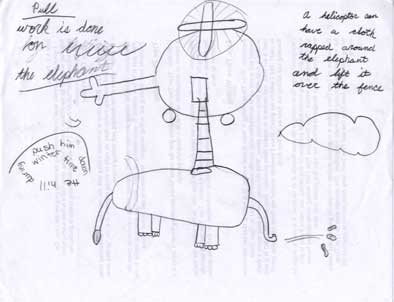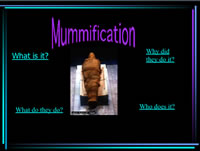 |
 |
 |
|
 |
 |
| (click
on either drawing for an enlarged image) |
|
The activation
of students' prior knowledge is perhaps the single
most powerful tool a teacher has. By using short
descriptive writing, simple verbal explanations,
or with creative images as seen above, students
can pull from a vast experiential and knowledge
base. It is on this prior knowledge that the teacher
can begin scaffolding further comprehension of a
concept. Here, I gave the students a problem of
trying to move an elephant into a fenced zoo enclosure
that had no roof or gates. As a group they came
up with many ideas, from helicopters and cranes,
to ramps and even dynamite. It was with these depictions
and explanations that I "assessed" their
present understanding of simple machines before
embarking on a simple machine unit of study.
|
 |
|
For
almost any individual learning can be made
more engaging by focusing on a particular
interest of the individual. Incorporating
a concept into an already familiar example
or reference point will further ensure that
the learner is engaged and taking an active
part in his or her learning. After an exhausting
study of Newton's Laws of Motion and other
forces that affect motion I gave the students
an opportunity to incorporate their new knowledge
of motion into a project that would serve
as both an assessment and a review for the
coming test. After eliciting responses as
to what would make a successful board game
(i.e. - dice, spinner, pieces to move, colorful
game board, well thought out questions, clear
start and finish) I had the students create
their own lists as to what would make a decent
board game. After more discussion I gave them
the task of creating "Fun in Motion"
board games which used every term and definition
from the chapter we had just studied in Science.
The students were not only excited to be creating
their own games, but also relished the prospect
of creating questions and cards based on the
definitions that were difficult enough to
stump one another. They reviewed the material
for the test and had the opportunity to gain
experience working as a group.
|
|
|
|
(click
on any of the board game to see an enlarged image)
Through increased integration of technology, students are able to take the concept of real world projects like board games, and create even more immersive and engaging learning tools. Creating databases, using spreadsheets, and producing presentations which challenge their notion of what Office Software can do, learners are given new perspectives on class materials and how production software can be utilized beyond more basic uses. Below are examples of a few projects which my students have created using PowerPoint. The presentation on Mummification is not a typical slideshow, in that the user is encouraged to interact with the presentation, clicking on links, and directing their own experience with the presentation. We designed this project with a children's museum in mind and newer electronic and digital displays you might find at a museum. The student created a self-guided museum exhibit designed to enhance a larger exhibit on Ancient Egypt, and succeeded quite well. The other two presentations were based on earlier projects that I had previously done on paper with my students. One uses PowerPoint's ability to have objects move in order to illustrate Sir Isaac Newton's laws of motion, while the presentation is another example of an interactive Ancient Egypt exhibit.

Click the image above to view a web-friendly version of Mummification |

Click the image above to download the actual Newton's Illustrated Laws of Motion |

Click the image above to view a web-friendly version of Egyptian Writing
|
|
Return
to Top
|
|
|
 |
|